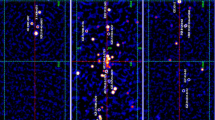Abstract
As cataclysmic variables, SU Ursae Majoris stars1,2 are short-period binary systems consisting of a red dwarf star that fills its Roche-lobe and spills material to an accretion disk around a white dwarf. SU UMa systems undergo outbursts (episodes of increased mass transfer in the disk) of two distinct types: normal outbursts that last a few days, and superoutbursts that last up to 2 weeks. Superhumps are periodic ∼30% brightness variations of unknown origin seen only during the superoutbursts. The superhump period is several per cent longer than the binary orbital period. Both the accretion disk3,4 and the red dwarf5 have been proposed as possible sites for the superhump. Although superhumps occur in both eclipsing and non-eclipsing systems, observations of the eclipsing systems Z Cha and OY Car may help to discriminate between these two classes of models. Whitehurst et al.5 have shown that the superhumps in Z Cha are not deeply eclipsed, and argue that superhumps therefore cannot originate in the accretion disk. In their starspot model, superhumps arise in a bright active region located in the equatorial belt of the red dwarf. By contrast, the light curve synthesis results reported here show explicitly that disk models produce a shallow partial eclipse of the superhump light, compatible with the eclipse depth measurements of Whitehurst et al., provided the superhump source is not concentrated into a small region of the disk. The starspot model is shown to be inconsistent with the observed shapes of superhumps unless radiation emerges from the starspot in a narrow (≲35°) fan beam with its long axis in the direction of stellar latitude.
Similar content being viewed by others
References
Vogt, N. Astr. Astrophys. 88, 66–76 (1980).
Warner, B. Preprint (NATO Advanced Studies Institute, Cambridge, 1983).
Papaloizou, J. & Pringle, J. E. Mon. Not. R. astr. Soc. 189, 293–297 (1979).
Vogt, N. Astrophys. J. 252, 653–667 (1982).
Whitehurst, R., Bath, G. T. & Charles, P. A. Nature 309, 768–770 (1984).
Smak, J. Acta astr. (submitted).
Kzreminski, V. & Vogt, N. Astrophys. J. (submitted).
Cook, M. C. thesis, Univ. Cambridge (1982).
Author information
Authors and Affiliations
Rights and permissions
About this article
Cite this article
Horne, K. A disk origin for superhumps in Ursae Majoris variables. Nature 312, 348–351 (1984). https://doi.org/10.1038/312348a0
Received:
Accepted:
Issue Date:
DOI: https://doi.org/10.1038/312348a0
- Springer Nature Limited




